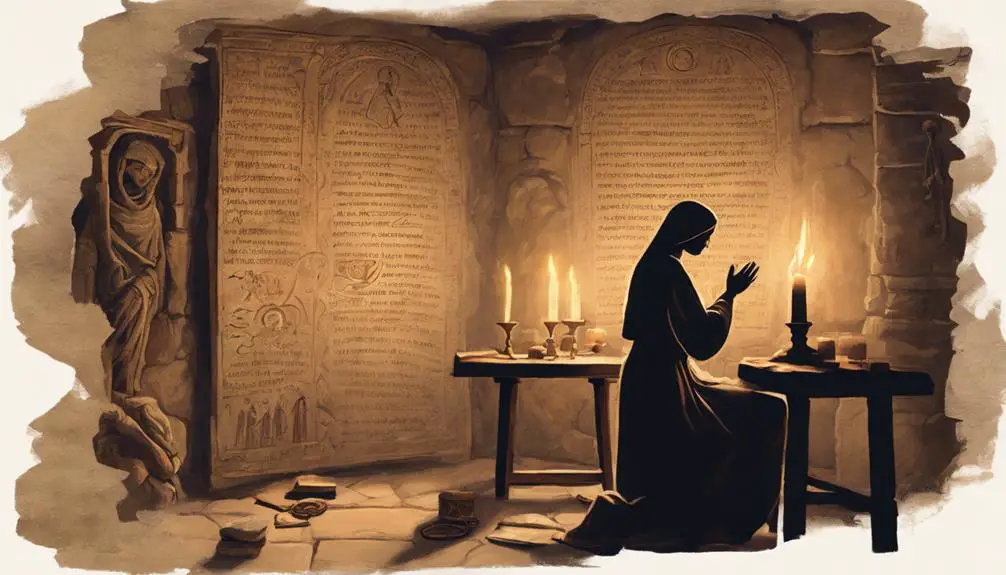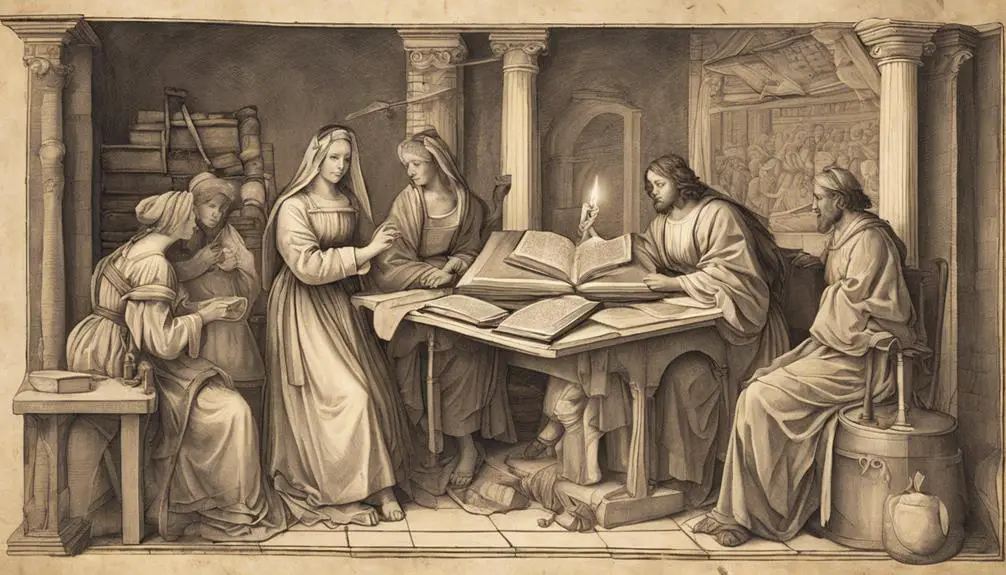Hidden in scripture, the fate of Peter's wife sparks curiosity about her influence in early Christianity—dive into the mystery.

What Happened to Peter's Wife in the Bible
While the Bible vividly recounts Peter's acts of faith and moments of doubt, it whispers barely a word about his wife, leaving you to wonder about the shadow she cast in early Christianity.
You know Peter was married because of a brief mention of his mother-in-law, but what became of his wife, and what role, if any, did she play in the nascent Church?
The silence of the scriptures contrasts sharply with the chatter of early Church fathers, who provide tantalizing clues but no clear answers. This gap in the biblical narrative invites you to explore further, promising insights into not just Peter's life but also the early Christian community's dynamics.
Key Takeaways
- The Bible provides sparse details about Peter's wife, including a miracle involving her mother but not her fate.
- Early Christian writings, such as those by Clement and Eusebius, hint at her role but leave her ultimate fate and contributions largely unrecorded.
- Traditional accounts and scholarly theories suggest she played a significant role in early Christianity, possibly even facing martyrdom alongside Peter.
- Despite the lack of specific details about her life and death, Peter's wife is considered an important figure in the early Christian community.
Biblical Mentions of Peter's Wife

While the Bible doesn't extensively detail the life of Peter's wife, it offers crucial insights into her existence through sparse mentions, primarily highlighting her indirect role in Peter's ministry. One significant instance is the healing miracle performed on her mother, which not only underscores Peter's faith but also hints at the familial dynamics and personal life of Peter, including his marriage. This event, recorded in the Gospels, serves as a rare window into the personal sphere of one of Jesus' closest disciples, suggesting that his family, by extension, played a part in his spiritual journey.
Moreover, understanding marriage customs of the time provides a backdrop against which these brief mentions gain depth. Marriages were pivotal in social and religious contexts, suggesting that Peter's wife would have had a considerable influence on his day-to-day life and possibly his ministry. The societal norms and expectations regarding marriage and family life in ancient Jewish culture would have shaped their lives significantly, offering a context within which Peter's commitment to his apostolic duties, alongside maintaining his role as a husband, can be appreciated. This interplay between personal commitment and spiritual duty highlights the complexity of Peter's life and ministry, with his wife playing an indispensable though largely unrecorded role.
Early Church Fathers' Accounts
Turning to the accounts of the early Church Fathers, we find additional insights into the life of Peter's wife, shedding light on her influence and presence in early Christian communities. These historical figures, including Clement of Alexandria and Eusebius of Caesarea, offer narratives that contribute significantly to understanding her role and the circumstances surrounding her life. However, the wife's name remains elusive in these accounts, a reflection of the period's documentation practices rather than an oversight of her significance.
The debate surrounding her martyrdom is rooted in these ancient writings. Clement of Alexandria, for instance, references an episode where Peter is said to have watched his wife being led to her death, offering her words of encouragement. This account, while poignant, is wrapped in the larger discussion of marital fidelity and Christian martyrdom. It underscores the complexities of early Christian testimonies, where the blending of personal sacrifice and faith emerges distinctly.
These early Church Fathers' accounts, while not providing exhaustive details, illuminate the broader context of Peter's wife's life. They underscore her as an integral figure within the nascent Christian movement, reflecting on her possible martyrdom and the absence of her name, which remains a subject of scholarly inquiry.
Historical and Traditional Insights

Exploring historical and traditional insights offers a broader understanding of Peter's wife's role within early Christianity, shedding light on her influence beyond the narratives provided by the early Church Fathers. When you delve into the historical context of Peter's marriage, you uncover a landscape where personal details about apostles and their families weren't meticulously recorded, yet the existence and significance of these relationships were acknowledged. This exploration brings to light the intriguing absence of explicit mention of Peter's wife's name in canonical scriptures, a detail that has fueled much speculation and scholarly debate.
The tradition, however, fills some of these gaps, suggesting names and narratives that have been passed down through generations, albeit with varying degrees of historical credibility. These traditional accounts, while not universally accepted as historical fact, provide insight into the early Christian community's perception of Peter's marital life. They paint a picture of a woman who, despite the scarcity of details regarding her identity and life, was integral to the personal story of one of Christianity's most pivotal figures. In examining Peter's marriage through both historical and traditional lenses, you gain a nuanced understanding of the early Christian community's dynamics and the roles individuals played within it.
Her Role in Early Christianity
Peter's wife played a crucial yet often overlooked role in the early Christian community, embodying the supportive yet influential presence behind one of its foundational figures. Her contributions, while not always explicitly documented, highlight the essential part women played in the nascent stages of Christianity.
- Women's leadership: Peter's wife, though not directly mentioned as a leader, likely facilitated gatherings and provided a model for female leadership within the community. Her actions and the respect she commanded would have set a precedent for women's roles in church leadership, challenging the prevailing norms of her time.
- Community impact: Her influence extended beyond her immediate family, impacting the wider Christian community. Through her support and perhaps even her hospitality, she'd have played a key role in fostering the sense of unity and fellowship that was critical for the early church's survival and growth.
- Mentorship and Support: It's plausible that Peter's wife offered mentorship to other women, guiding them in their new faith and roles within the community. This support system would have been vital for the retention and spread of Christian beliefs.
Analyzing her role offers insights into the dynamic contributions of women in early Christianity, underscoring the importance of women's leadership and community impact during this formative period.
Scholarly Interpretations and Theories

Scholars have offered various interpretations and theories about the role of Peter's wife in the early Christian community, reflecting on her potential influence and contributions. Delving into the sparse biblical references and early church writings, they've pieced together scenarios that underscore her significance beyond merely being Peter's spouse. The intrigue surrounding the wife's identity has led to discussions about her role in spreading Christianity and supporting Peter in his ministry.
The cultural implications of her role are profound, suggesting that women, although seldom mentioned, played pivotal roles in the nascent Christian movement. Some scholars propose that her presence alongside Peter, especially in contexts where he healed and preached, could signify a partnership that transcended traditional marital roles, hinting at a more egalitarian approach within early Christian circles.
Others argue that the mention of her suffering (as inferred from Paul's epistle) indicates a shared commitment to the cause, potentially elevating her status to that of a fellow missionary. This perspective challenges traditional narratives, offering a broader understanding of gender dynamics and leadership within early Christianity. These scholarly endeavors not only illuminate her influence but also contribute to a richer, more nuanced comprehension of the early church's social fabric.
Frequently Asked Questions
How Did Peter's Marriage Influence His Relationship With Other Apostles and Early Christian Communities?
Peter's marriage influenced his apostolic travels and leadership dynamics among the early Christian communities and other apostles. You'd notice his unique position, balancing family responsibilities with his mission, offering a distinct perspective on leadership and community life.
This dynamic affected how he related to both his fellow apostles and the broader Christian communities, showcasing a blend of personal experience and apostolic authority that shaped the early church's development and relational strategies.
Are There Any Modern Cultural or Artistic Representations of Peter's Wife, and How Do They Differ From Ancient Portrayals?
You'll find that modern artistic interpretations of Peter's wife vary significantly from ancient portrayals, reflecting shifts in cultural significance. Contemporary artists often imbue her with more agency and complexity, a departure from her more passive, traditional roles.
This evolution in depiction underscores how cultural contexts shape biblical narratives' artistic representation. It's fascinating to see how these interpretations offer new insights into her character, enriching our understanding of her story within a modern framework.
How Have Different Christian Denominations Historically Viewed Peter's Marital Status, and Has This View Evolved Over Time?
You'd think the marital status of a man who lived millennia ago wouldn't spark so much drama, yet here we are. Denominational debates rage over Peter's ring finger like it's the latest celebrity gossip.
Historical interpretations have shifted, showing that views on his marital status aren't set in stone but evolve, mirroring broader societal changes. Different Christian sects have swung from acceptance to skepticism, proving once again, history—and opinion—is anything but static.
What Are the Psychological and Sociological Implications of Peter Having a Wife for Understanding Family Dynamics in Early Christian Settings?
You're delving into how Peter having a wife shapes our understanding of family dynamics in early Christian settings. This exploration reveals insights into gender roles and marital expectations of the time. Analyzing this aspect offers a scholarly, objective view on how early Christians navigated family life, highlighting the sociological and psychological underpinnings of their community structure.
It's crucial for recognizing the evolving nature of familial roles within historical religious contexts.
How Does the Existence of Peter's Wife Challenge or Reinforce Contemporary Christian Views on Clerical Celibacy and the Role of Women in Church Leadership?
Imagine stepping into a time where celibacy debates and women's ordination weren't just modern dialogues but ancient discussions.
Peter's marriage throws a wrench in contemporary Christian views on clerical celibacy, challenging the notion that spiritual leadership demands solitude. It simultaneously reinforces the potential for women's leadership roles in the church, suggesting early Christianity may have embraced a more inclusive approach.
Analyzing this, you're not just revisiting history; you're questioning long-held beliefs.
Conclusion
In conclusion, the scant mentions and subtle hints about Peter's wife in the Bible, complemented by early Church Fathers' accounts, offer a glimpse into her existence and role.
Isn't it fascinating how, despite the limited information, she emerges as a figure of significance in early Christianity?
Through historical, traditional, and scholarly lenses, we're invited to piece together her story, shedding light on the contributions and challenges faced by women in the nascent Christian community.



Sign up